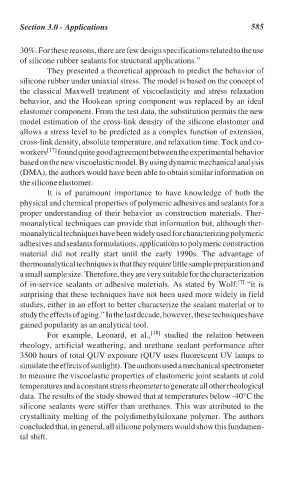Page 617 - Handbook of Thermal Analysis of Construction Materials
P. 617
Section 3.0 - Applications 585
30%. For these reasons, there are few design specifications related to the use
of silicone rubber sealants for structural applications.”
They presented a theoretical approach to predict the behavior of
silicone rubber under uniaxial stress. The model is based on the concept of
the classical Maxwell treatment of viscoelasticity and stress relaxation
behavior, and the Hookean spring component was replaced by an ideal
elastomer component. From the test data, the substitution permits the new
model estimation of the cross-link density of the silicone elastomer and
allows a stress level to be predicted as a complex function of extension,
cross-link density, absolute temperature, and relaxation time. Tock and co-
workers [17] found quite good agreement between the experimental behavior
based on the new viscoelastic model. By using dynamic mechanical analysis
(DMA), the authors would have been able to obtain similar information on
the silicone elastomer.
It is of paramount importance to have knowledge of both the
physical and chemical properties of polymeric adhesives and sealants for a
proper understanding of their behavior as construction materials. Ther-
moanalytical techniques can provide that information but, although ther-
moanalytical techniques have been widely used for characterizing polymeric
adhesives and sealants formulations, applications to polymeric construction
material did not really start until the early 1990s. The advantage of
thermoanalytical techniques is that they require little sample preparation and
a small sample size. Therefore, they are very suitable for the characterization
of in-service sealants or adhesive materials. As stated by Wolf: [7] “it is
surprising that these techniques have not been used more widely in field
studies, either in an effort to better characterize the sealant material or to
study the effects of aging.” In the last decade, however, these techniques have
gained popularity as an analytical tool.
For example, Leonard, et al., [18] studied the relation between
rheology, artificial weathering, and urethane sealant performance after
3500 hours of total QUV exposure (QUV uses fluorescent UV lamps to
simulate the effects of sunlight). The authors used a mechanical spectrometer
to measure the viscoelastic properties of elastomeric joint sealants at cold
temperatures and a constant stress rheometer to generate all other rheological
data. The results of the study showed that at temperatures below -40°C the
silicone sealants were stiffer than urethanes. This was attributed to the
crystallinity melting of the polydimethylsiloxane polymer. The authors
concluded that, in general, all silicone polymers would show this fundamen-
tal shift.

